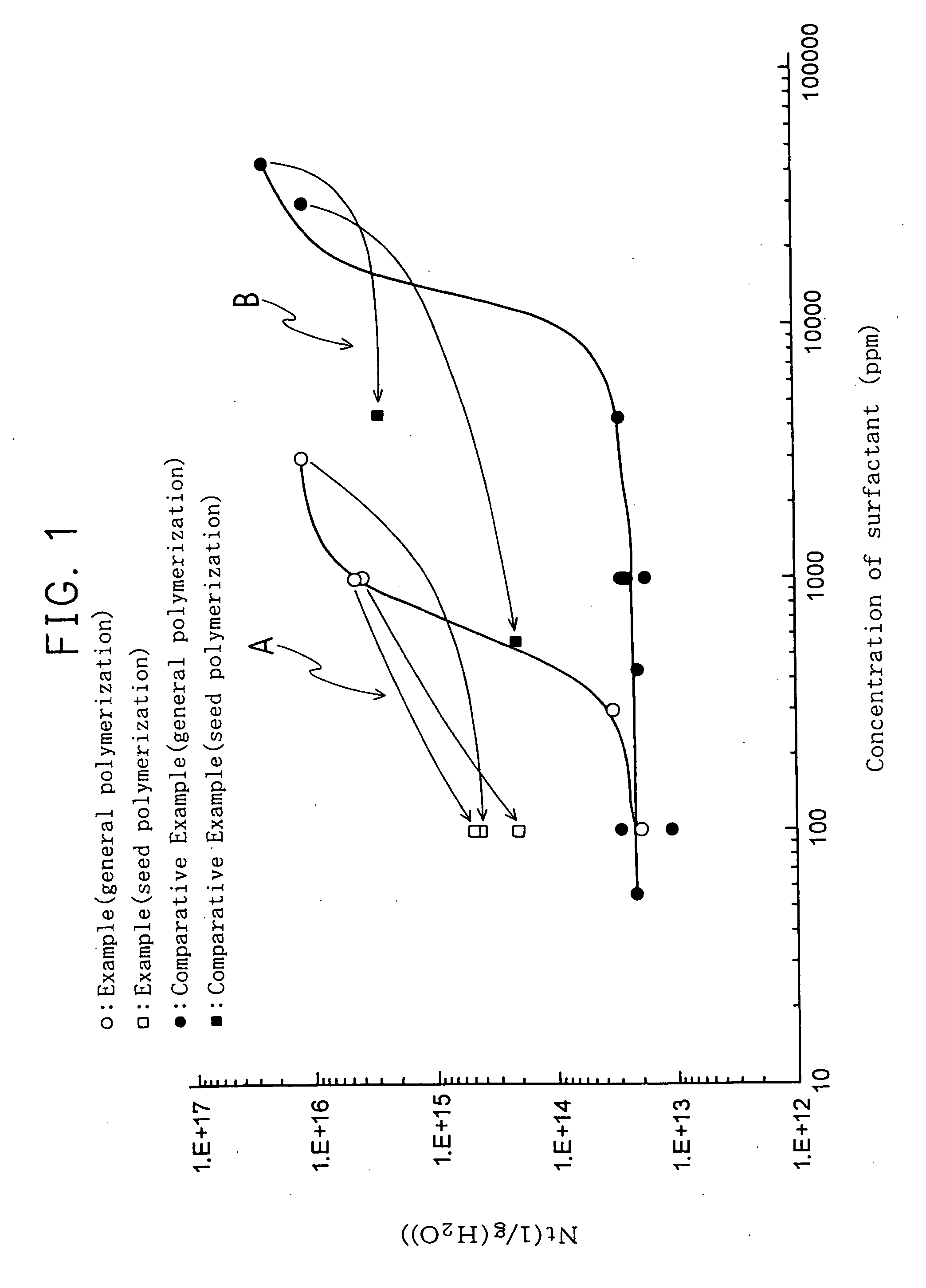Process for preparing fluoropolymer
a technology of fluoropolymer and process, which is applied in the field of process for preparing fluoropolymer, can solve the problems of small number of generated particles, water resistance reduction of surfactant, etc., and achieve excellent production efficiency
- Summary
- Abstract
- Description
- Claims
- Application Information
AI Technical Summary
Benefits of technology
Problems solved by technology
Method used
Image
Examples
example 1
[0043] A stainless autoclave having a 0.1 L capacity was charged with 50 g of ion exchange water, 0.05 g of ammonium persulfate (APS), and 0.005 g of Hostapur SAS93 (secondary alkanesulfonate Na salt, ((CH3(CH2)m)(CH3(CH2)n)CHSO3Na, m+n=14 to 17, available from Clariant Japan K.K.) as a surfactant, and the autoclave was purged sufficiently with nitrogen and form a vacuum, thereafter, a mixed gas comprising 65% by mol of hexafluoropropylene (HFP) and 35% by mol of 1,1-difluoroethylene (VdF) was charged under the vacuum condition so as to have a pressure of 1 MPa. This autoclave was immersed in a water bath equipped with a horizontal mobile agitator, which was previously set at 80° C., and a polymerization reaction was initiated. After three minutes, the pressure in the autoclave became constant and, then, lowered with progress of the polymerization reaction. The polymerization reaction was carried out for 1 hour.
[0044] After terminating the polymerization reaction, the autoclave was...
example 2
[0045] A stainless autoclave having a 0.1 L capacity was charged with 50 g of ion exchange water, 0.05 g of ammonium persulfate (APS), and 0.015 g of Hostapur SAS93 (secondary alkanesulfonate Na salt, ((CH3(CH2)m)(CH3(CH2)n)CHSO3Na, m+n=14 to 17, available from Clariant Japan K.K.), and the autoclave was purged sufficiently with nitrogen and form a vacuum, thereafter, a mixed gas comprising 65% by mol of hexafluoropropylene (HFP) and 35% by mol of 1,1-difluoroethylene (VdF) was charged under the vacuum condition so as to have a pressure of 1 MPa. This autoclave was immersed in a water bath equipped with a horizontal mobile agitator which was previously set at a temperature of 80° C., and a polymerization reaction was initiated. After three minutes, the pressure in the autoclave became constant and, then, lowered with progress of the polymerization reaction. The polymerization reaction was carried out for 1.67 hours.
[0046] After terminating the polymerization reaction, the autoclave...
example 3
[0047] A stainless autoclave having a 0.1 L capacity was charged with 50 g of ion exchange water, 0.05 g of ammonium persulfate (APS), and 0.05 g of Hostapur SAS93 (secondary alkanesulfonate Na salt, ((CH3(CH2)m)(CH3(CH2)n)CHSO3Na, m+n=14 to 17 available from Clariant Japan K.K.), and the autoclave was purged sufficiently with nitrogen and form a vacuum, thereafter, a mixed gas comprising 65% by mol of hexafluoropropylene (HFP) and 35% by mol of 1,1-difluoroethylene (VdF) was charged under the vacuum condition so as to give a pressure of 1 MPa. This autoclave was immersed in a water bath equipped with a horizontal mobile agitator which was previously controlled at a temperature of 80° C., and a polymerization reaction was initiated. After three minutes, the pressure in the autoclave became constant and, then, lowered with progress of the polymerization reaction. The polymerization reaction was carried out for 1 hour.
[0048] After terminating the polymerization reaction, the autoclav...
PUM
| Property | Measurement | Unit |
|---|---|---|
| total carbon number | aaaaa | aaaaa |
| carbon number | aaaaa | aaaaa |
| molar ratio | aaaaa | aaaaa |
Abstract
Description
Claims
Application Information
 Login to View More
Login to View More - R&D
- Intellectual Property
- Life Sciences
- Materials
- Tech Scout
- Unparalleled Data Quality
- Higher Quality Content
- 60% Fewer Hallucinations
Browse by: Latest US Patents, China's latest patents, Technical Efficacy Thesaurus, Application Domain, Technology Topic, Popular Technical Reports.
© 2025 PatSnap. All rights reserved.Legal|Privacy policy|Modern Slavery Act Transparency Statement|Sitemap|About US| Contact US: help@patsnap.com



